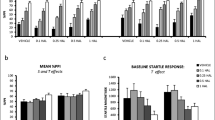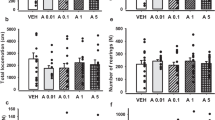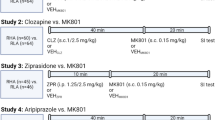Abstract
Rationale
Acute administration of clozapine (a gold standard of atypical antipsychotics) disrupts avoidance response in rodents, while repeated administration often causes a tolerance effect.
Objective
The present study investigated the neuroanatomical basis and receptor mechanisms of acute and repeated effects of clozapine treatment in the conditioned avoidance response test in male Sprague-Dawley rats.
Methods
2,5-dimethoxy-4-iodo-amphetamine (DOI, a preferential 5-HT2A/2C agonist) or quinpirole (a preferential dopamine D2/3 agonist) was microinjected into the medial prefrontal cortex (mPFC) or nucleus accumbens shell (NAs), and their effects on the acute and long-term avoidance disruptive effect of clozapine were tested.
Results
Intra-mPFC microinjection of quinpirole enhanced the acute avoidance disruptive effect of clozapine (10 mg/kg, sc), while DOI microinjections reduced it marginally. Repeated administration of clozapine (10 mg/kg, sc) daily for 5 days caused a progressive decrease in its inhibition of avoidance responding, indicating tolerance development. Intra-mPFC microinjection of DOI at 25.0 (but not 5.0) μg/side during this period completely abolished the expression of clozapine tolerance. This was indicated by the finding that clozapine-treated rats centrally infused with 25.0 μg/side DOI did not show higher levels of avoidance responses than the vehicle-treated rats in the clozapine challenge test. Microinjection of DOI into the mPFC immediately before the challenge test also decreased the expression of clozapine tolerance.
Conclusions
Acute behavioral effect of clozapine can be enhanced by activation of the D2/3 receptors in the mPFC. Clozapine tolerance expression relies on the neuroplasticity initiated by its antagonist action against 5-HT2A/2C receptors in the mPFC.





Similar content being viewed by others
References
Atkins JB, Chlan-Fourney J, Nye HE, Hiroi N, Carlezon WA Jr, Nestler EJ (1999) Region-specific induction of deltaFosB by repeated administration of typical versus atypical antipsychotic drugs. Synapse 33:118–128
Beyer CE, Steketee JD (2000) Intra-medial prefrontal cortex injection of quinpirole, but not SKF 38393, blocks the acute motor-stimulant response to cocaine in the rat. Psychopharmacology (Berl) 151:211–218
Borison RL, Diamond BI (1983) Regional selectivity of neuroleptic drugs: an argument for site specificity. Brain Res Bull 11:215–218
Browning JL, Patel T, Brandt PC, Young KA, Holcomb LA, Hicks PB (2005) Clozapine and the mitogen-activated protein kinase signal transduction pathway: implications for antipsychotic actions. Biol Psychiatry 57:617–623
Di Giovanni G, Di Matteo V, Di Mascio M, Esposito E (2000) Preferential modulation of mesolimbic vs. nigrostriatal dopaminergic function by serotonin(2C/2B) receptor agonists: a combined in vivo electrophysiological and microdialysis study. Synapse 35:53–61
Di Matteo V, Cacchio M, Di Giulio C, Esposito E (2002) Role of serotonin(2C) receptors in the control of brain dopaminergic function. Pharmacol Biochem Behav 71:727–734
Feng M, Sui N, Li M (2013) Environmental and behavioral controls of the expression of clozapine tolerance: evidence from a novel across-model transfer paradigm. Behav Brain Res 238:178–187
Gao J, Li Y, Zhu N, Brimijoin S, Sui N (2013) Roles of dopaminergic innervation of nucleus accumbens shell and dorsolateral caudate-putamen in cue-induced morphine seeking after prolonged abstinence and the underlying D1- and D2-like receptor mechanisms in rats. J Psychopharmacol 27:181–191
Goudie AJ, Cole JC, Sumnall HR (2007a) Olanzapine and JL13 induce cross-tolerance to the clozapine discriminative stimulus in rats. Behav Pharmacol 18:9–17
Goudie AJ, Cooper GD, Cole JC, Sumnall HR (2007b) Cyproheptadine resembles clozapine in vivo following both acute and chronic administration in rats. J Psychopharmacol 21:179–190
Grauer SM, Graf R, Navarra R, Sung A, Logue SF, Stack G, Huselton C, Liu Z, Comery TA, Marquis KL, Rosenzweig-Lipson S (2009) WAY-163909, a 5-HT2C agonist, enhances the preclinical potency of current antipsychotics. Psychopharmacology (Berl) 204:37–48
Ichikawa J, Dai J, Meltzer HY (2001a) DOI, a 5-HT2A/2C receptor agonist, attenuates clozapine-induced cortical dopamine release. Brain Res 907:151–155
Ichikawa J, Ishii H, Bonaccorso S, Fowler WL, O’Laughlin IA, Meltzer HY (2001b) 5-HT(2A) and D(2) receptor blockade increases cortical DA release via 5-HT(1A) receptor activation: a possible mechanism of atypical antipsychotic-induced cortical dopamine release. J Neurochem 76:1521–1531
Kane J, Honigfeld G, Singer J, Meltzer H (1988) Clozapine for the treatment-resistant schizophrenic. A double-blind comparison with chlorpromazine. Arch Gen Psychiatry 45:789–796
Kapur S, VanderSpek SC, Brownlee BA, Nobrega JN (2003) Antipsychotic dosing in preclinical models is often unrepresentative of the clinical condition: a suggested solution based on in vivo occupancy. J Pharmacol Exp Ther 305:625–631
Kuroki T, Meltzer HY, Ichikawa J (1999) Effects of antipsychotic drugs on extracellular dopamine levels in rat medial prefrontal cortex and nucleus accumbens. J Pharmacol Exp Ther 288:774–781
Li M, Fletcher PJ, Kapur S (2007) Time course of the antipsychotic effect and the underlying behavioral mechanisms. Neuropsychopharmacology 32:263–272
Li M, Sun T, Zhang C, Hu G (2010) Distinct neural mechanisms underlying acute and repeated administration of antipsychotic drugs in rat avoidance conditioning. Psychopharmacology (Berl) 212:45–57
Li M, He W, Heupel K (2011) Administration of clozapine to a mother rat potentiates pup ultrasonic vocalization in response to separation and re-separation: contrast with haloperidol. Behav Brain Res 222:385–389
Li M, Sun T, Mead A (2012) Clozapine, but not olanzapine, disrupts conditioned avoidance response in rats by antagonizing 5-HT2A/2C receptors. J Neural Transm 119:497–505
Lukasiewicz S, Polit A, Kedracka-Krok S, Wedzony K, Mackowiak M, Dziedzicka-Wasylewska M (2010) Hetero-dimerization of serotonin 5-HT(2A) and dopamine D(2) receptors. Biochim Biophys Acta 1803: 1347–58
McEvoy JP, Lieberman JA, Stroup TS, Davis SM, Meltzer HY, Rosenheck RA, Swartz MS, Perkins DO, Keefe RS, Davis CE, Severe J, Hsiao JK, Investigators C (2006) Effectiveness of clozapine versus olanzapine, quetiapine, and risperidone in patients with chronic schizophrenia who did not respond to prior atypical antipsychotic treatment. Am J Psychiatry 163:600–610
McOmish CE, Lira A, Hanks JB, Gingrich JA (2012) Clozapine-induced locomotor suppression is mediated by 5-HT(2A) receptors in the forebrain. Neuropsychopharmacology 37:2747–2755
Mead A, Li M (2009) Avoidance-suppressing effect of antipsychotic drugs is progressively potentiated after repeated administration: an interoceptive drug state mechanism. J Psychopharmacol 24:1045–1053
Meltzer H (2002) Mechanisms of action of atypical antipsychotic drugs. In: Davis KL, Charney D, Coyle JT, Nemeroff C (eds) Neuropsychopharmacology the fifth generation of progress: an official publication of the American College of Neuropsychopharmacology. Lippincott Williams & Wilkins, Philadelphia
Moran-Gates T, Gan L, Park YS, Zhang K, Baldessarini RJ, Tarazi FI (2006) Repeated antipsychotic drug exposure in developing rats: dopamine receptor effects. Synapse 59:92–100
Ohashi K, Hamamura T, Lee Y, Fujiwara Y, Suzuki H, Kuroda S (2000) Clozapine- and olanzapine-induced Fos expression in the rat medial prefrontal cortex is mediated by beta-adrenoceptors. Neuropsychopharmacology 23:162–169
Paxinos G, Watson C (2004) The rat brain in stereotaxic coordinates, 5th edn. Elsevier/Academic, Amsterdam
Pehek EA, Yamamoto BK (1994) Differential effects of locally administered clozapine and haloperidol on dopamine efflux in the rat prefrontal cortex and caudate-putamen. J Neurochem 63:2118–2124
Qiao J, Li H, Li M (2013) Olanzapine sensitization and clozapine tolerance: from adolescence to adulthood in the conditioned avoidance response model. Neuropsychopharmacology 38:513–524
Qin R, Chen Y, Li M (2013) Repeated asenapine treatment produces a sensitization effect in two preclinical tests of antipsychotic activity. Neuropharmacology 75C:356–364
Reynolds SM, Berridge KC (2001) Fear and feeding in the nucleus accumbens shell: rostrocaudal segregation of GABA-elicited defensive behavior versus eating behavior. J Neurosci 21:3261–3270
Richard JM, Berridge KC (2011) Metabotropic glutamate receptor blockade in nucleus accumbens shell shifts affective valence towards fear and disgust. Eur J Neurosci 33:736–747
Robertson GS, Matsumura H, Fibiger HC (1994) Induction patterns of Fos-like immunoreactivity in the forebrain as predictors of atypical antipsychotic activity. J Pharmacol Exp Ther 271:1058–1066
Sanger DJ (1985) The effects of clozapine on shuttle-box avoidance responding in rats: comparisons with haloperidol and chlordiazepoxide. Pharmacol Biochem Behav 23:231–236
Shu Q, Hu G, Li M (2014) Adult response to olanzapine or clozapine treatment is altered by adolescent antipsychotic exposure: a preclinical test in the phencyclidine hyperlocomotion model. J Psychopharmacol 28:363–375
Sipes TE, Geyer MA (1997) DOI disrupts prepulse inhibition of startle in rats via 5-HT2A receptors in the ventral pallidum. Brain Res 761:97–104
Sorge RE, Martin LJ, Isbester KA, Sotocinal SG, Rosen S, Tuttle AH, Wieskopf JS, Acland EL, Dokova A, Kadoura B, Leger P, Mapplebeck JC, McPhail M, Delaney A, Wigerblad G, Schumann AP, Quinn T, Frasnelli J, Svensson CI, Sternberg WF, Mogil JS (2014) Olfactory exposure to males, including men, causes stress and related analgesia in rodents. Nat Meth
Sotoyama H, Zheng Y, Iwakura Y, Mizuno M, Aizawa M, Shcherbakova K, Wang R, Namba H, Nawa H (2011) Pallidal hyperdopaminergic innervation underlying D2 receptor-dependent behavioral deficits in the schizophrenia animal model established by EGF. PLoS One 6:e25831
Stanford JA, Fowler SC (1997) Subchronic effects of clozapine and haloperidol on rats’ forelimb force and duration during a press-while-licking task. Psychopharmacology (Berl) 130:249–253
Steward LJ, Kennedy MD, Morris BJ, Pratt JA (2004) The atypical antipsychotic drug clozapine enhances chronic PCP-induced regulation of prefrontal cortex 5-HT2A receptors. Neuropharmacology 47:527–537
Sun T, Hu G, Li M (2009) Repeated antipsychotic treatment progressively potentiates inhibition on phencyclidine-induced hyperlocomotion, but attenuates inhibition on amphetamine-induced hyperlocomotion: relevance to animal models of antipsychotic drugs. Eur J Pharmacol 602:334–342
Tarazi FI, Yeghiayan SK, Neumeyer JL, Baldessarini RJ (1998) Medial prefrontal cortical D2 and striatolimbic D4 dopamine receptors: common targets for typical and atypical antipsychotic drugs. Prog Neuropsychopharmacol Biol Psychiatry 22:693–707
Trevitt J, Atherton A, Aberman J, Salamone JD (1998) Effects of subchronic administration of clozapine, thioridazine and haloperidol on tests related to extrapyramidal motor function in the rat. Psychopharmacology (Berl) 137:61–66
Varvel SA, Vann RE, Wise LE, Philibin SD, Porter JH (2002) Effects of antipsychotic drugs on operant responding after acute and repeated administration. Psychopharmacology (Berl) 160:182–191
Vazquez-Borsetti P, Cortes R, Artigas F (2009) Pyramidal neurons in rat prefrontal cortex projecting to ventral tegmental area and dorsal raphe nucleus express 5-HT2A receptors. Cereb Cortex 19:1678–1686
Villanueva HF, Porter JH (1993) Differential tolerance to the behavioral effects of chronic pimozide and clozapine on multiple random interval responding in rats. Behav Pharmacol 4:201–208
Wadenberg ML, Hicks PB (1999) The conditioned avoidance response test re-evaluated: is it a sensitive test for the detection of potentially atypical antipsychotics? Neurosci Biobehav Rev 23:851–862
Wadenberg ML, Hicks PB, Richter JT, Young KA (1998) Enhancement of antipsychoticlike properties of raclopride in rats using the selective serotonin2A receptor antagonist MDL 100,907. Biol Psychiatry 44:508–515
Wadenberg MG, Browning JL, Young KA, Hicks PB (2001a) Antagonism at 5-HT(2A) receptors potentiates the effect of haloperidol in a conditioned avoidance response task in rats. Pharmacol Biochem Behav 68:363–370
Wadenberg ML, Soliman A, VanderSpek SC, Kapur S (2001b) Dopamine D(2) receptor occupancy is a common mechanism underlying animal models of antipsychotics and their clinical effects. Neuropsychopharmacology 25:633–641
Wan FJ, Swerdlow NR (1993) Intra-accumbens infusion of quinpirole impairs sensorimotor gating of acoustic startle in rats. Psychopharmacology (Berl) 113:103–109
Winstanley CA, Theobald DE, Dalley JW, Glennon JC, Robbins TW (2004) 5-HT2A and 5-HT2C receptor antagonists have opposing effects on a measure of impulsivity: interactions with global 5-HT depletion. Psychopharmacology (Berl) 176:376–385
Wischhof L, Hollensteiner KJ, Koch M (2011) Impulsive behaviour in rats induced by intracortical DOI infusions is antagonized by co-administration of an mGlu2/3 receptor agonist. Behav Pharmacol 22:805–813
Young CD, Bubser M, Meltzer HY, Deutch AY (1999) Clozapine pretreatment modifies haloperidol-elicited forebrain Fos induction: a regionally-specific double dissociation. Psychopharmacology (Berl) 144:255–263
Zhang C, Li M (2012) Contextual and behavioral control of antipsychotic sensitization induced by haloperidol and olanzapine. Behav Pharmacol 23:66–79
Zhao C, Li M (2009) The receptor mechanisms underlying the disruptive effects of haloperidol and clozapine on rat maternal behavior: a double dissociation between dopamine D(2) and 5-HT(2A/2C) receptors. Pharmacol Biochem Behav
Zhao C, Li M (2010) C-Fos identification of neuroanatomical sites associated with haloperidol and clozapine disruption of maternal behavior in the rat. Neuroscience 166:1043–1055
Zhao C, Sun T, Li M (2012) Neural basis of the potentiated inhibition of repeated haloperidol and clozapine treatment on the phencyclidine-induced hyperlocomotion. Prog Neuropsychopharmacol Biol Psychiatry 38:175–182
Acknowledgments
We would like to thank Ms. Shinn-Yi Chou and Ms. Natashia Swalve for their thoughtful comments on an earlier version of this manuscript. Research reported in this paper was supported by the National Institute of Mental Health of the National Institutes of Health under award number R01MH085635 to Professor Ming Li.
Conflicts of interest
The authors declare no conflict financial interests.
Author information
Authors and Affiliations
Corresponding author
Additional information
Min Feng and Jun Gao contributed equally to this work.
Electronic supplementary material
Below is the link to the electronic supplementary material.
ESM 1
(DOCX 617 kb)
Rights and permissions
About this article
Cite this article
Feng, M., Gao, J., Sui, N. et al. Effects of central activation of serotonin 5-HT2A/2C or dopamine D2/3 receptors on the acute and repeated effects of clozapine in the conditioned avoidance response test. Psychopharmacology 232, 1219–1230 (2015). https://doi.org/10.1007/s00213-014-3756-2
Received:
Accepted:
Published:
Issue Date:
DOI: https://doi.org/10.1007/s00213-014-3756-2




